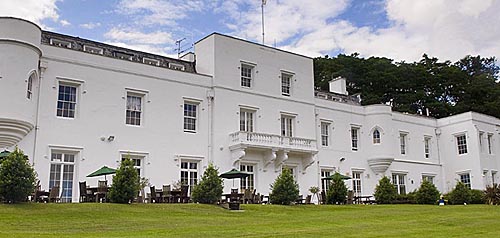 |
 |
|||
|
|
Sophia Lodge The first building on this site was called the Hermitage. It may have been built in the late 17th century and was certainly named after a medieval hermit’s cell and chapel of St. Leonard which had preceded it. The dedication was later transferred to the hill on which it stood. An old legend tells how Sir Lancelot of Round Table fame stayed with the hermit before attending a famous joust in Winchester. In 1717 a Robert Butler was in residence but, by 1737, the building was apparently “old and falling into disrepair”. It was then the Windsor home of Frances, Countess of Hertford, Lady of the Bedchamber to Queen Caroline, who wrote that she “loved the situation… There is something in the retiredness… and the beautiful prospect from it”. It still today has magnificent views of Windsor and the castle. The house was rebuilt in 1750 and, twenty-three years later, it was purchased by Prince William, Duke of Gloucester, to add to his adjoining Gloucester Lodge estate (since called St. Leonard’s Hill). He had been banished from the Royal Court by his brother, George III, for having married an illegitimate commoner, the widowed Countess Waldegrave. It was in this year that their daughter, Princess Sophia, was born, so he renamed his new property in her honour, as Sophia Farm or Lodge. It was apparently used as a Summer residence for little Sophia’s three half-sisters, the Ladies Elizabeth, Charlotte and Anna Waldegrave (later the Countess Waldegrave, Duchess of Grafton and Mrs. Adm. Lord Hugh Seymour (a nephew of Field-Admiral Henry Conway Seymour) respectively). Despite the couple regaining favour with the Duke’s brother, the Duchess was never accepted as Royalty in England. So, with debts mounting, they moved abroad in 1779, selling both their Clewer properties two years later. Sophia Lodge was bought by George Birch for £10,000. The next owner was William Dawson who employed the architect, James Wyatt, to completely remodel the building in a castellated Georgian Gothic Revival style in 1813. In 1850, the estate was purchased by Sir Theodore Brinckman, who needed a family seat since his mother had sold their previous one, at Holly Grove (alias Forest Lodge) in the Great Park, when he was thirty-one. The sale of Sophia Lodge was not a smooth one and Sir Theodore brought an unsuccessful case to the Court of Chancery alleging that the vendor had concealed the fact that the house stood on copyhold land. Sir Theodore was a Whig politician and seems to have spent most of his time chasing a peerage that Prime Minister George Canning was supposed to have promised his father. He also changed the name of Sophia Lodge to St. Leonard’s (not to be confused with St. Leonard's Hill). His son and namesake inherited the property in 1880, but his son, the third baronet called Theodore, sold up in 1921 to James Railton.
St. Leonard's sits at the centre of Legoland. It can be seen behind the Raft River Racers Ride.
|
|||
| © Nash Ford Publishing 2013. All Rights Reserved. | ||||




 In 1932, the house was bought by Anna Thomson Dodge, the widow of the American automobile magnate, Horace Dodge, who had built the first engines for the Ford Motor Co. She was one of the wealthiest women in the World. Unfortunately, she almost completely rebuilt the house at St. Leonard’s to become the rather
less interesting thirteen-bay building that we see today. Joseph Kennedy used this house as his country estate in 1938, when he was American Ambassador to the UK. After this, it sadly remained unoccupied for many years. In 1966, the estate was acquired by Billy Smart and the house became part of his Windsor Safari Park complex. Since 1992, it has been the headquarters of Legoland Windsor.
In 1932, the house was bought by Anna Thomson Dodge, the widow of the American automobile magnate, Horace Dodge, who had built the first engines for the Ford Motor Co. She was one of the wealthiest women in the World. Unfortunately, she almost completely rebuilt the house at St. Leonard’s to become the rather
less interesting thirteen-bay building that we see today. Joseph Kennedy used this house as his country estate in 1938, when he was American Ambassador to the UK. After this, it sadly remained unoccupied for many years. In 1966, the estate was acquired by Billy Smart and the house became part of his Windsor Safari Park complex. Since 1992, it has been the headquarters of Legoland Windsor.